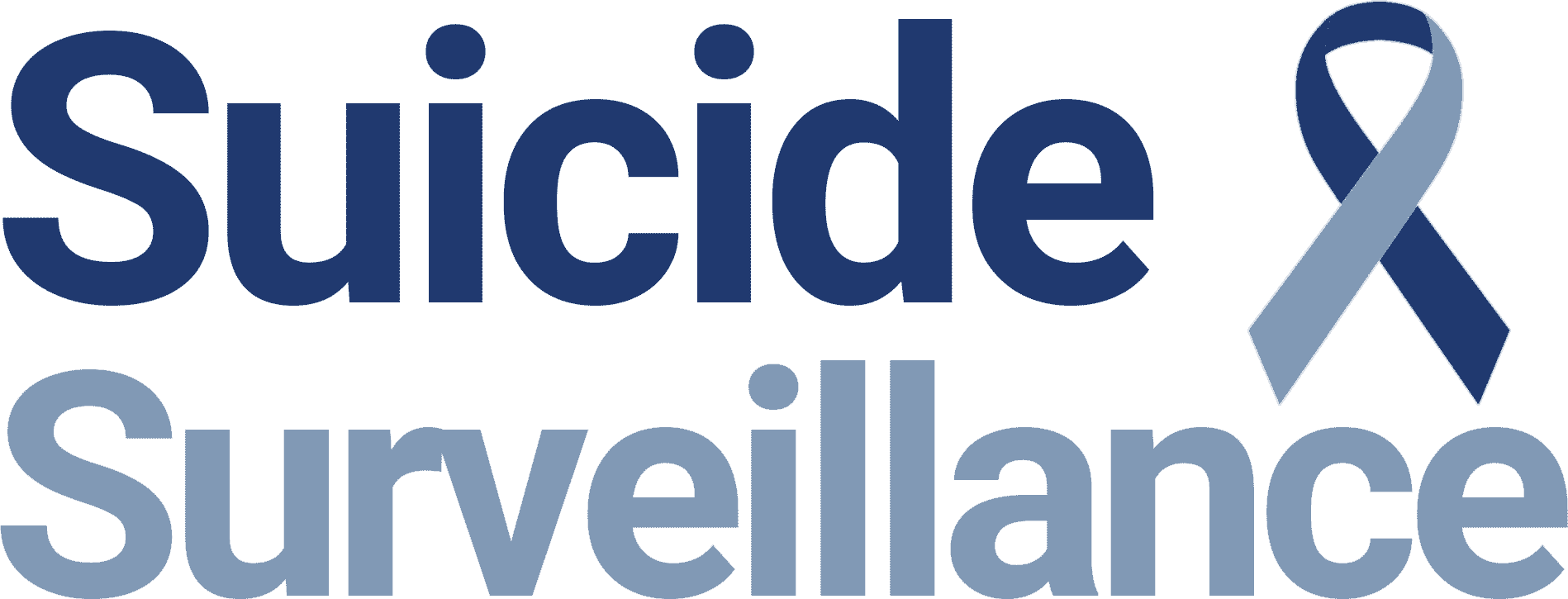Our Solutions - Suicide Surveillance
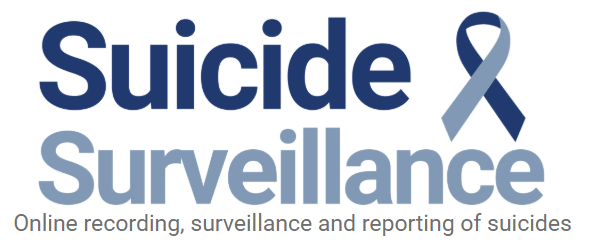
Online recording, surveillance and reporting of suicides
Summary
Suicide is an epidemic that continues to take the lives of thousands of individuals every year in the UK, with a staggering 6,507 deaths by suicide registered in 2018 alone, an 11.8% increase from the previous year. Such tragedies often have a deeply profound knock-on effect on family, friends and even the wider local community too, and those bereaved by suicide can become a high-risk group themselves if neither postvention support nor preventative measures are established. However, we are now beginning to see progressive steps being implemented nationwide to reduce rates of suicide.
A zero-suicide ambition across mental health services. £25 million funding into addressing high-risk groups. Suicide prevention plans implemented within local authorities across the country. These are just three key steps forward in 2019’s first ever Cross-Government Suicide Prevention Plan all aimed at reducing rates of suicide in the UK. This, along with the rise in national conversation surrounding the devastating statistics on suicide, are proof that suicide prevention is becoming a priority.
Targeted action is fundamental, and it must be recognised that the collection and reporting of data associated with suspected suicides is the future of suicide prevention.
The QES Suicide Surveillance system, initially developed in partnership with THRIVE LDN and South Yorkshire, enables multi-agencies to gain a clear, informative view on each completed suicide. The range of information inputted into the system by multi-agency partners at a local level (i.e. police, ambulance, mental health services) enables the tying together of a series of small details to provide one comprehensive view of circumstances. This collection of information from multi-agency partners is essential in the ability to learn from, and react to, emerging patterns and trends in suicide.
System Features
A knowledge and understanding of certain behaviours, characteristics and personal circumstances, coupled with key attention to location (both of residence and place of death), delivers an integral and unique opportunity for identifying risk factors and preventing further tragedies.
The QES Suicide Surveillance system has been designed by our clients, with user experience and ease of information collection and reporting in mind, to make a leap forwards towards a zero-suicide ambition.

Accessibility
- The system requires a two-factor authentication log-in process for robust security, ensuring relevant information is only seen by those with granted access permissions
- The landing page brings the administrative user to the Case List where all open and closed cases are easily accessible for viewing information or filling out an enquiry form
- In order to prevent duplicate cases, the system automatically runs a duplication check process in the background. Should the case already exist, the user will be notified of this
- The system has a user-friendly interface that is intuitive and easy to navigate, enabling local services and partners to easily input and access important information in one secure, centralised location
- The Suicide Surveillance system is accessible for submitting suspected suicides before a coroner’s report is complete, to avoid delays and ensure learning is immediate. The details can be easily updated to a completed suicide, or removed, when a coroner’s report is received
- Upon setting up the system, the new client is able to locally configure their system, including determining which partners will be involved. This often includes emergency services as well as local physical and mental health services
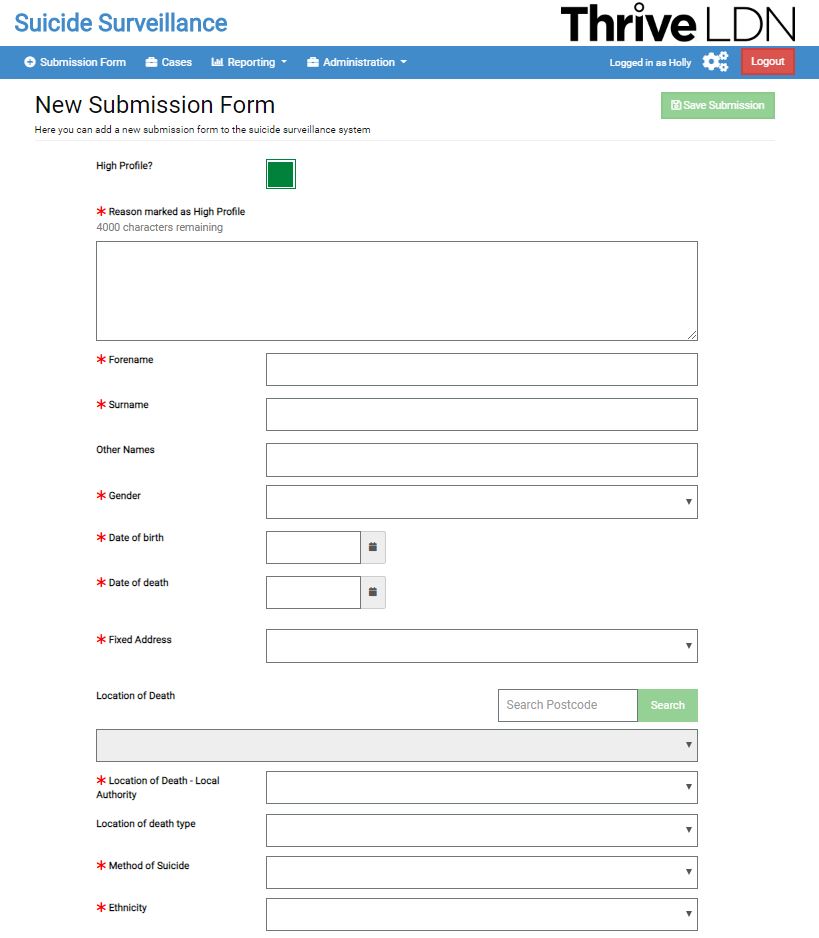
Submission Form
- Partners have access to an online submission form, to advise the local services of a completed/suspected suicide
- Upon completion of a new submission form, a case is automatically created in the system and a two-step notification process will be triggered sending the following automatic alerts:
- - The relevant local authority users receive a daily email at 8am notifying them of any newly reported suspected/completed suicides submitted to the system
- - An instant alert is sent to all multi-agency partners (i.e. police, ambulance, mental health services etc.) with a link to the case requesting that they submit their enquiry form
- There is an immediate question on the submission form to ascertain whether the case is high profile (e.g. a famous person or a case that may gain a significant amount of media coverage). If a user ticks the ‘high profile’ question, it will restrict access to the case to only senior partners to complete the enquiry form, for full discretion
- If the high-profile box has been checked, the system will prompt a mandatory text field following on to detail why the case has been marked as high-profile
- The form has been designed to include a variety of different data fields, to ease the completion process for partners and improve quality of information return. These include drop down fields, calendar format for quick date entries, tick boxes, text fields, mandatory and conditional fields, which have all proven to be a success with our user group
- Location of Residence and Death have a postcode lookup field, to help determine which local authority the case is relevant to and easily confirm if this is out of region
- Demographics within the form (e.g. employment status, sexual orientation, mental health issues) offer a greater insight into the person, ultimately helping to determine trends and patterns across other cases with the aim to reduce and prevent further suicides
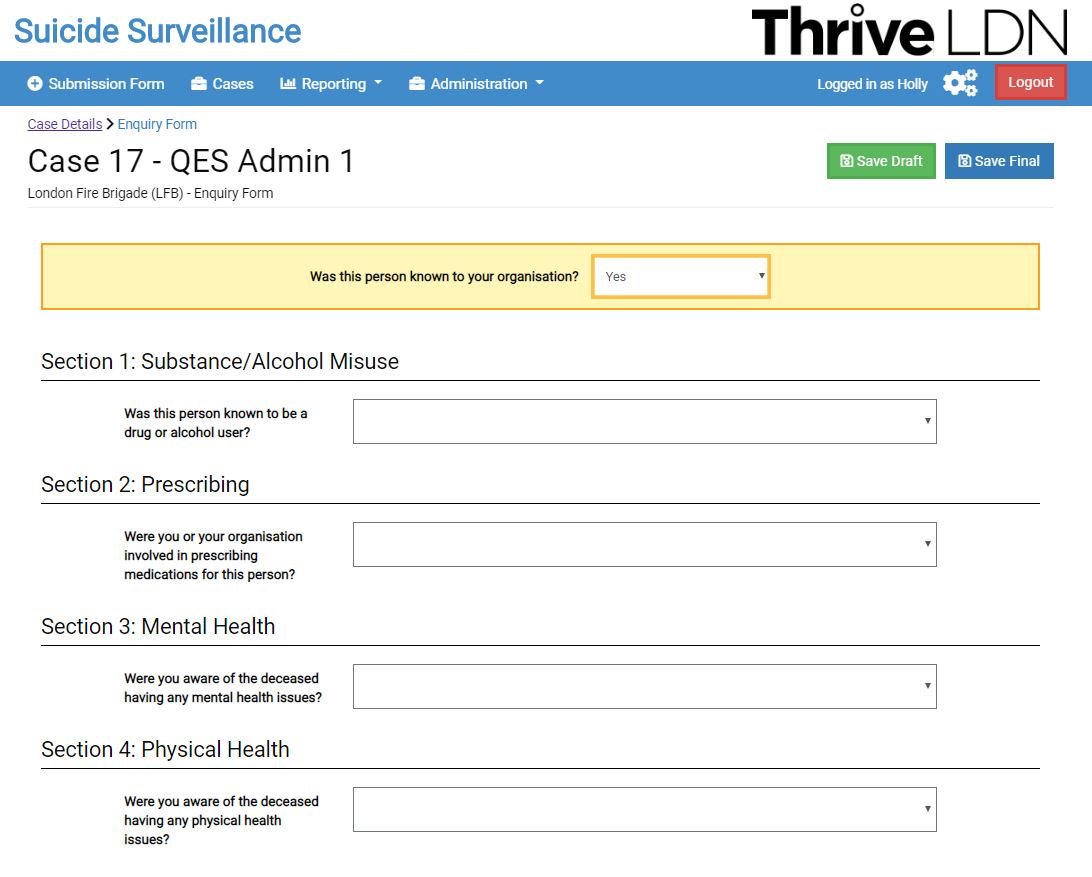
Enquiry Forms
- Enquiry forms are automatically distributed via the system to all relevant multi-agency partners
- Partners are able to access the forms to the requested cases securely via an automatically generated email link
- Users are able to partially populate the enquiry form, and save as draft as many times as needed before returning to finalise their response
- The collection of this information provides the local authority with a comprehensive view of the circumstances surrounding a suspected or completed suicide
- The immediate question within an enquiry form establishes whether a partnering organisation had any involvement with the person. If so, they will be prompted to answer further questions covering a range of details about their collective history and the series of events leading up to the attempted/completed suicide
- The system encourages the partner agencies to provide as much detail as they can, including topics such as alcohol misuse, physical/mental health, a timeline of interactions and even any witnesses or family/friends who may be affected by the suicide to help with offering postvention support
- Partners are required to complete their form response within 28 days. The system will automatically generate an email reminder after 21 days to partners if the form has not yet been completed
- Once a case has been submitted as final by a partner, the local authority will be automatically alerted and will be able to instantly view the new information regarding the suspected/completed suicide
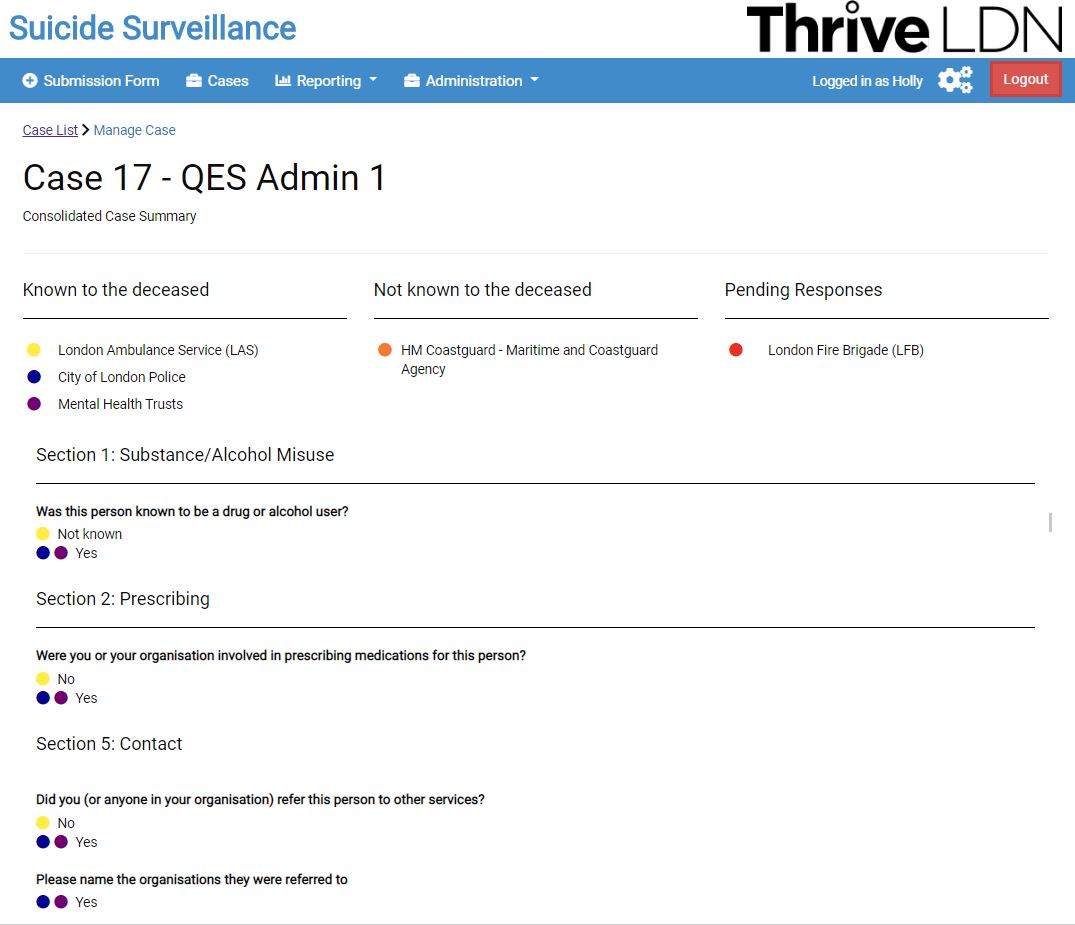
Cases
- All cases are displayed to administrative users and authorised partners in a clear case list, displaying detail such as case ID, name, local authority, high profile, etc.
- A sophisticated search facility is available on the Case List screen for users to quickly access a specific case
- The information visible on the Case List page is dependent on the user’s access permissions, showing only what is relevant to that particular user for further security and privacy of information
- Within a specific case summary, administrators can see an overview of the initial submission form, as well as partner enquiry forms. This screen indicates whether partners are yet to start their form (not started), midway through (open) or have completed and finalised their responses (closed)
- Partners can only view their own forms and not those of others, this ensures data security, and also prevents their version of events being subconsciously influenced by others and improves the reliability of information
- A consolidated case view is automatically created within the system, displaying all multi-agency partner responses to each question in the enquiry form. This provides a full view of the agencies involved with the person and the circumstances surrounding the suspected/completed suicide
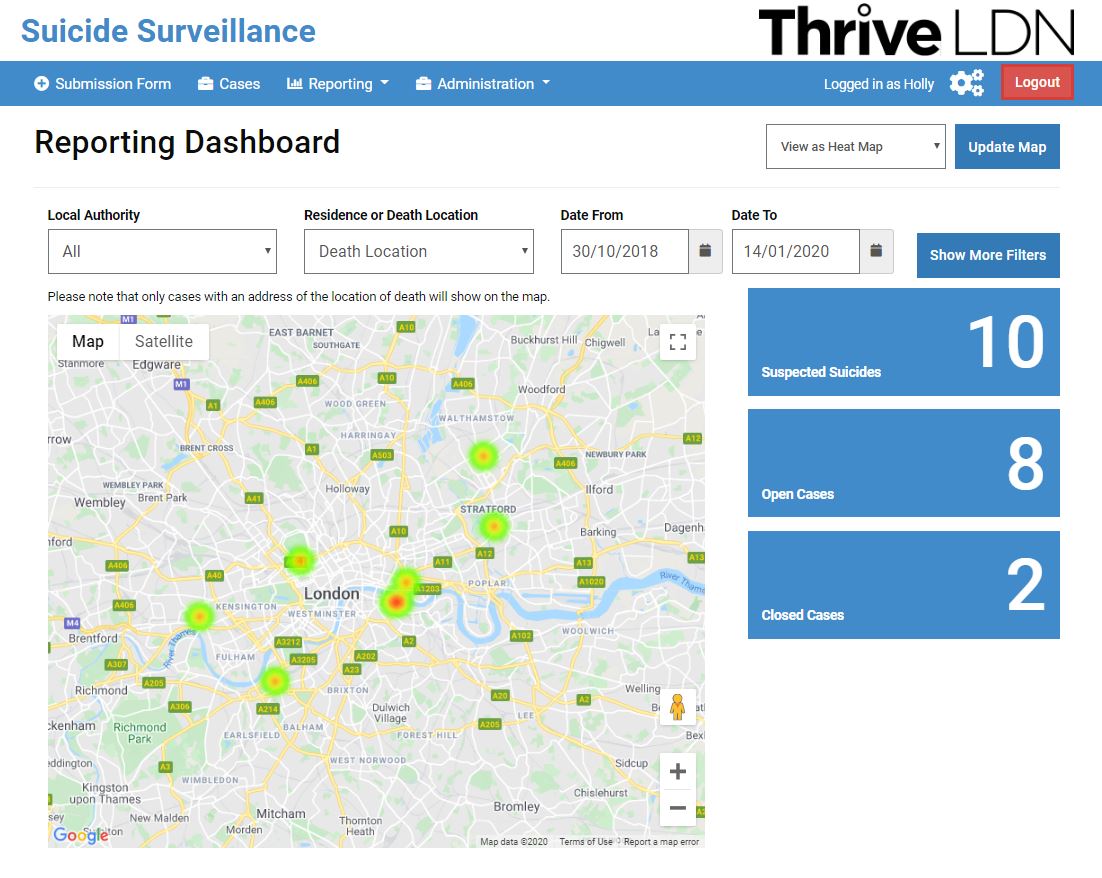
Dashboard and Reporting
- An interactive digital dashboard is available within the system, which provides instant access to statistics on the position of suspected and completed suicides in real time.
- The dashboard can be configured to display data for certain date parameters, only certain areas or local authorities, and by location of residence or death
- Dashboard reporting, such as heat and marker maps are available to visually highlight the locations of both residence and death within local authority areas, which can help to identify any emerging trends and patterns instantly
- Reports are downloadable and available in PDF, Excel or Word formats for further manipulation, analysis and publication
Security and GDPR
- The QES Suicide Surveillance system is secure and GDPR compliant
- Sensitive information is always secure, and never leaves the system via email or other autonomous methods
- Users can only access the system using a username, password and a 2-factor authentication code
- Reports are downloadable and available in PDF, Excel or Word formats for further manipulation, analysis and publication
- Security roles are set in place to restrict access permission for certain users and activities
- The system is web based and is https encrypted
- For further information on our GDPR compliance and data security, a full Information Governance document is available
